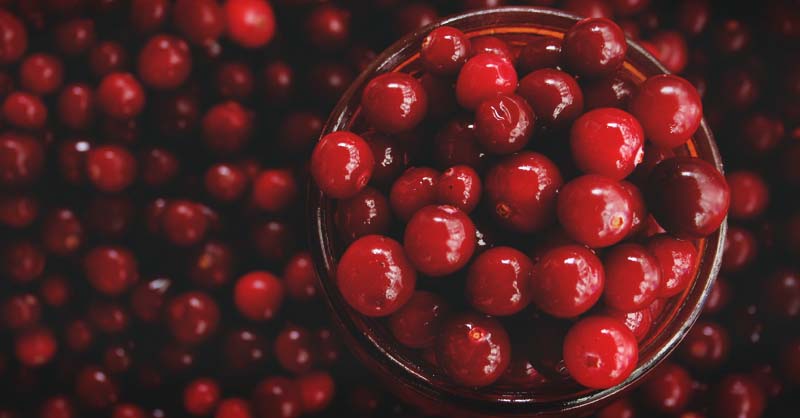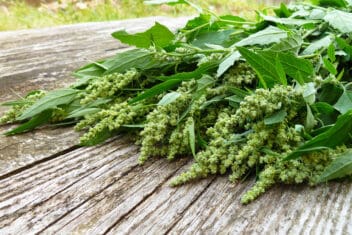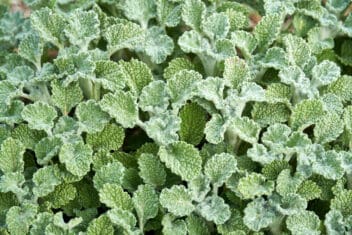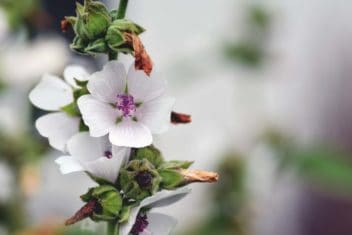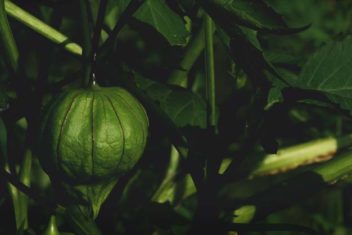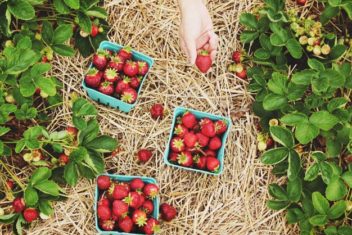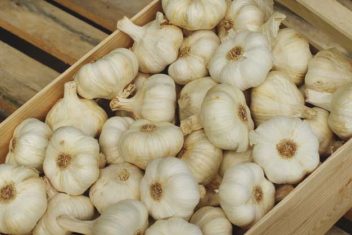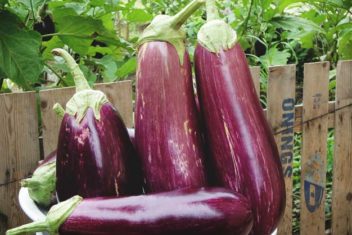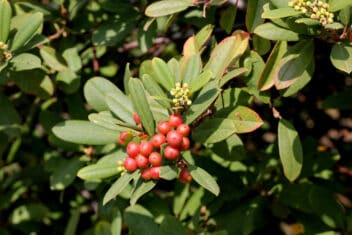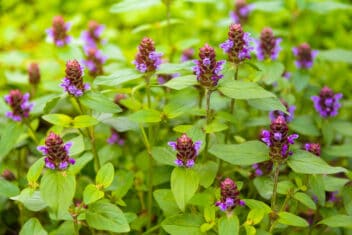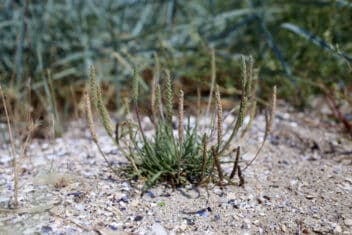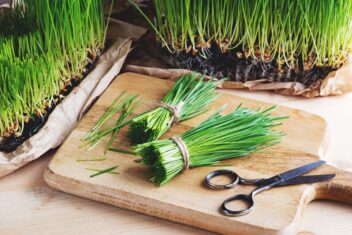When I say cranberries, what comes to mind? Perhaps cranberry sauce on your Thanksgiving table? A pile of them dried and heaped in your salad? What about cranberries growing in your garden?
If the last one didn’t immediately pop into your mind, you aren’t alone.
I used to assume that because they’re commercially grown underwater, I couldn’t grow cranberries in my own garden. But you can!
Here’s what you need to know.
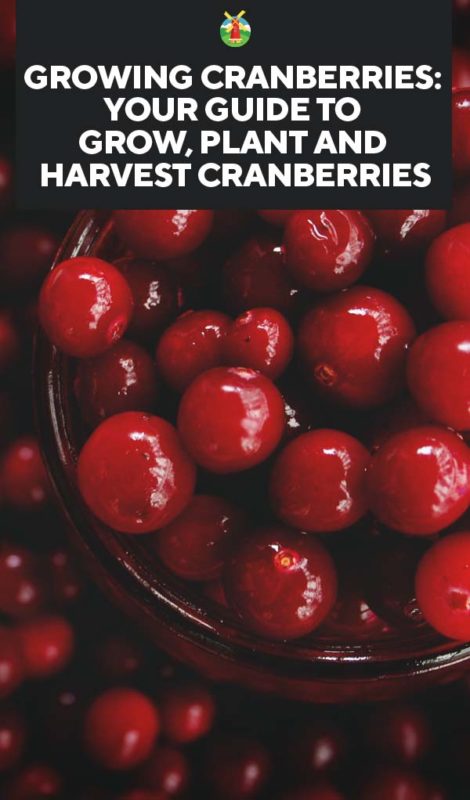
Cranberry Plant Info:
- Hardiness Zones: 2, 3, 4, 5, 6, 7, 8
- Soil: Loamy, sandy, clay, PH between 4.0 to 5.5, poorly-drained, moist, boggy
- Sun Exposure: Full sun
- Planting: Plant in fall from October to early November, in spring from mid-April to end May
- Spacing: 11 to 12 inches between plants and rows
- Depth: 2 to 6 inches
- Best Companions: Azalea, rhododendron, blueberry, lingonberry
- Worst Companions: Potato, tomato, cucumber
- Watering: Water constantly to keep the soil always wet
- Fertilizing: Top dress with a balanced fertilizer in spring for the first 3 years
- Common Problems: Proventuria early leaf spot, botryosphaeria fruit rot, red leaf spot, end rot, Phytophthora leaf spot, black-headed fireworm, cotton ball, cranberry blossom worm, cranberry fruitworm, cranberry tipworm, cranberry weevil, gypsy moth
- Harvest: 3 to 4 years after planting, when the fruits are red and ripe
Popular Cranberry Varieties
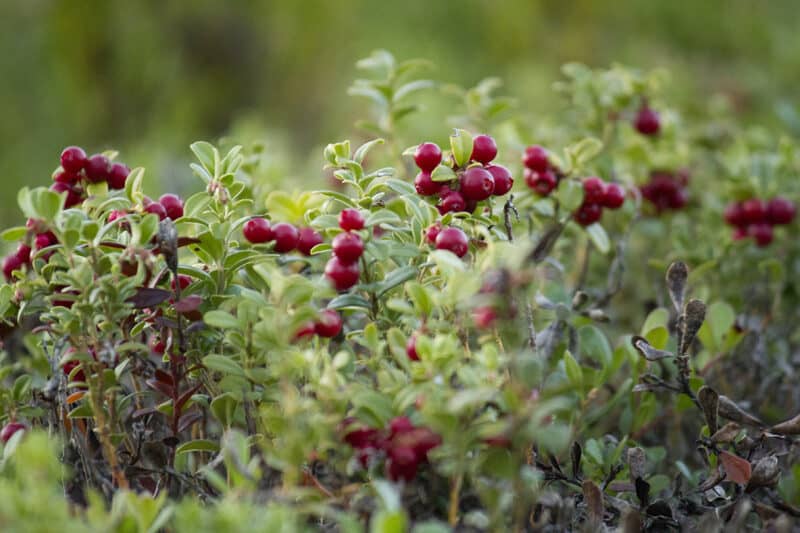
Cranberries look similar between varieties. However, there are a few differences between them. Here are the variations you should know about and what they’re capable of producing:
Stevens
This variety is known for being consistent in the amount produced per plant. They’re low-maintenance plants but produce fruits with a muted color.
GH1
‘GH1’ is known for being a heartier variety. It overwinters well in comparison to other types. The GH1 is also known for producing consistent amounts of fruit over the entire life of the plant, and the fruit is of a uniform color.
BG
This variety is known for being a consistent producer and also producing fruits with consistent coloring. If you want to know what to expect from your plants year after year, this could be a good choice for you.
Pilgrim King
The ‘Pilgrim King’ variety is known for producing a more abundant harvest. The harvest isn’t only plentiful, but the fruits are bigger and have consistent coloring, too.
Valley King
The ‘Valley King’ variety is known for producing a large harvest. This is nice because you’re getting more bang for your buck with the increase in production. This variety also produces larger fruits as well.
Granite Red
This variety is known for its firm fruit that stores well. The fruits are large and consistent in color.
How to Plant Cranberries
There are a few tricks you need to know to successfully grow cranberries in your garden. If you get the basics right, you should have success. Here’s what you need to know:
The Right Location
Cranberries are a perennial vine. They have branches that grow to be anywhere from 1-6 feet. When the vines are green, it means they’re growing, and when they’re brown it means they’ve gone dormant.
From these vines, small shoots sprout. These shoots will flower and from those flowers, the cranberries develop.
These vines have particular needs to produce and thrive. One of the most significant requirements for growing cranberries, as with most plants, is being in the right climate.
Cranberries need cold for at least three months out of the year. The temperatures in your area must get to 32-45°F for the plant to become dormant.
If you don’t live in a cold enough climate, cranberries won’t work in your garden.
Soil and Water
Cranberries have specific needs as far as soil and water go, as well. The soil should have a pH of approximately 4.5-5.5.
Though commercial businesses grow cranberries underwater, they don’t need to be covered with water in the garden.
In fact, the soil you plant the cranberries in should be well-drained to keep it from becoming soggy. If the roots stay too wet, they won’t produce as quickly as they would otherwise.
You can amend clay or sandy soil by adding well-rotted manure, compost, peat moss, or sand to the area.
Be sure to check your water as well. If the water is too alkaline, it can throw the pH off in your soil. Giving cranberries the proper environment to grow in is vital to their success.
Cranberries like full sun.
Plant Your Seedlings
It’s not a good idea to grow cranberries from seeds. They take up to two years to begin producing fruits. You don’t want to wait that long when starting out and seeing if cranberries will even work well in your location.
For this reason, you should buy seedlings. You’ll need one plant for every 2-3 feet. Over the years, the plants will become fuller and fill the entire space.
Harden Seedlings Off
When the seedlings or bushes (depending on how big your ordered plants are) arrive, they’ll need to be hardened off.
It’s a good idea to give them time to adjust to their new surroundings. You’ll leave the plants outside (as long as the temperature is over 50°F) for an hour the first day and bring it in at night.
Gradually extend the time that your new plant is spending outside. As long as the plant still seems healthy at the end of the week, you’re ready to plant.
Planting
When you plant your cranberry bushes, be sure to wait until the final spring frost is past. When the coast is clear, dig a hole only as deep as the container the plant arrived in.
Cranberries have shallow roots that only go into the soil approximately half a foot. If you make the hole too deep, the plant won’t thrive. When in doubt, know the crown of the plant should be level with the surface.
Again, be sure to plant each seedling or bush approximately two to three feet apart. You shouldn’t add fertilizer to the hole before planting.
Place the plant in the hole, cover the roots, and you’re good to go.
Raised Beds or Containers
Raised beds are a good choice for growing cranberries because it’s easier to control the quality of the soil. If you only want to grow a few cranberry plants, consider planting them in large containers.
You’ll follow all the steps above but use a quality potting mix as the base soil.
Be sure containers have holes in the bottom to keep the soil well-drained and keep a watchful eye on the pH level.
How to Care for Cranberries
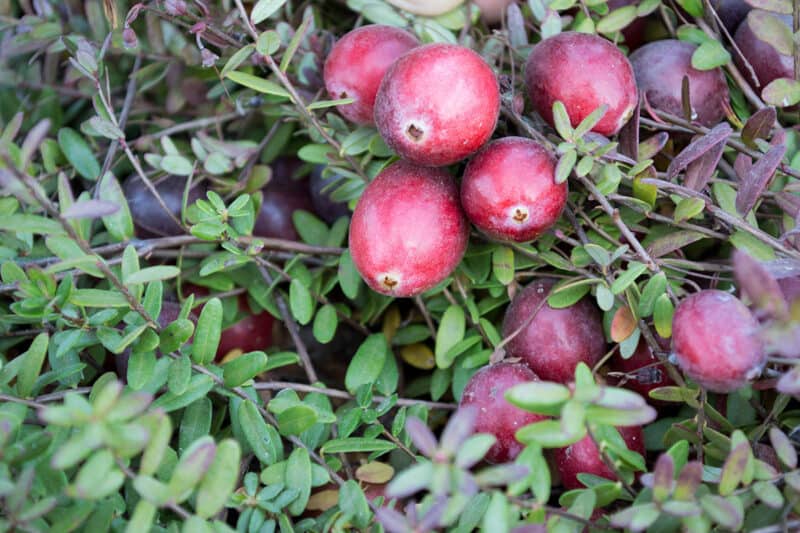
Follow these basic steps for providing proper care, and your berries should do well.
Water
When first planting the cranberry plants, you should water them every day for the first two weeks to help the roots become established.
After the plants are settled, you can reduce watering to every two to three days. The goal is to keep the soil damp, not drenched.
On average, cranberry plants need an inch of water per week. Keep a rain gauge handy to know how much water they get through the rain.
Once you know, you can supplement the rest of the water needed in one or two deep watering sessions throughout the week.
Weed
Because cranberries have shallow roots, you’ll need to control weeds through the mulch and by pulling weeds as necessary by hand.
It’s nothing overly complicated. The goal is to keep weeds from taking essential nutrients and necessities, which your cranberries need to survive and produce year after year.
Mulch
Mulch is a key ingredient in caring for cranberries. The most crucial time to mulch is when the plants are beginning to go dormant, but a light mulch year-round to help keep moisture in place is always a good idea.
The vines should be mulched heavily to protect them over the winter. If you live in a cooler location where snow is prominent, this is a good thing. The snow will provide extra insulation for your vines.
Fertilize
Each year as the cranberries begin to emerge, place a balanced fertilizer around each plant to give them a boost.
From there, it’s a good idea to add a slow-release fertilizer to them one time per month. If your plants are thriving after a few years, and you feel they don’t need additional fertilizer beyond the one dose in early spring, it’s your call.
If you have high-quality soil, they may not need the extra boost every month. You’ll know if your plants need nutrients as they become more established.
Add Sand
After the initial planting year, add 1/2 inch of sand to the base of each plant in early spring. Sand will help cut down on weeds around the plant and also helps to start more running vines.
This leads to a more productive plant, longevity, and a larger harvest for you over the years.
Prune
The cranberry plants should be pruned in the early part of spring, but only after the season in which they produced a harvest. Mature plants may often only produce every second year.
The long shoots where the blooms occur need to be pruned back. You should also prune out dead or damaged canes.
However, be sure not to prune the base runners that grow upwards. By pruning, you’re trying to encourage more upward growing vines to form.
Growing Cranberry Problems and Solutions
Cranberry plants have several pests and diseases that affect them. The pests and diseases you should watch out for are:
White Fly
These are small flies with white wings that hang around the bottom side of the leaves of your plant. They suck the juices from the plant to survive.
You can rid your plants of whiteflies by introducing beneficial insects, using traps, or by placing small amounts of dish soap on the plants.
Aphids
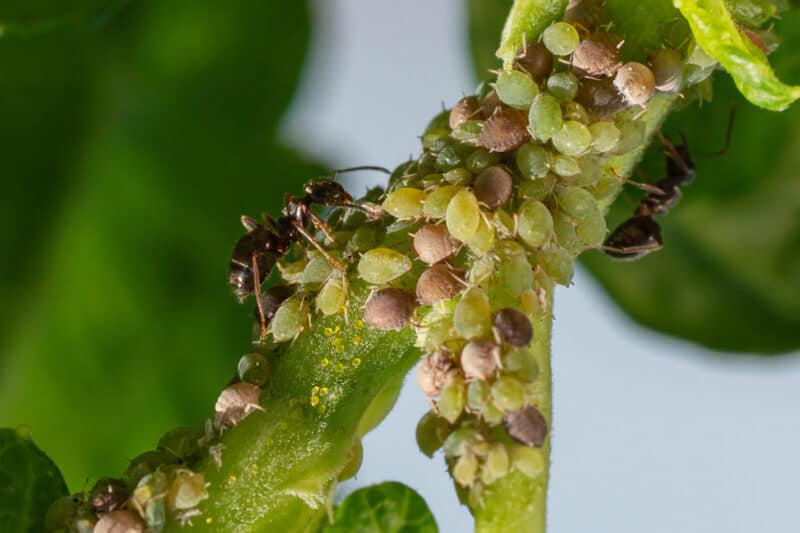
Aphids are found in most gardens. They attach themselves to your plants as they feast on them. You can rid your plants of aphids by giving them a cold spray with the water hose.
If they’re still attached, you can use a soapy mixture of soap and water to encourage them to fall off your plant.
Mealybugs
Mealybugs are white bugs with a waxy coating on them. They lay their eggs and live in the fruit your cranberry plants produce.
In turn, they cause mold to form and ruin your harvest. You can rid your plants of mealybugs by blasting them away with the water hose or by introducing beneficial insects to your garden.
Fruit Worm
Fruit worms look like a beetle when they’re fully grown. They produce small larvae that live on your cranberry plants. The adults harm the plant by cutting into the flowers where cranberries are formed. The larvae eat the fruit.
The best way to rid the plants of these pests is by handpicking them from your cranberry plants and by introducing beneficial insects to eat them.
Bacterial Leaf Spot
Bacterial leaf spot is a disease that causes blemishes to form on the leaves of the cranberry plants. They begin as discolored spots which eventually turn black.
The best way to deter this disease is by keeping a clean garden with plenty of air circulation. It’s a good idea to keep the area beneath the cranberry plants mulched, and you can apply a fungicide if needed.
Army Worm
These are worms that eat the leaves and fruit from your cranberry plants. You can rid your plants of them by using insecticides or introducing beneficial insects.
Consider planting other items in your garden that will attract birds as well. The birds will not only eat what you planted for them but also keep bugs under control.
Best and Worst Companion Plants for Cranberries
There are certain plants with that cranberries thrive when planted near. These plants are:
- Rhodendrons
- Azaleas
- Lingonberries
- Blueberries
How to Harvest and Store Cranberries
When your cranberries begin to produce, you’ll need to harvest them. You’ll know they’re ready for harvest when the seed turns brown and the outer berry turns a deep red.
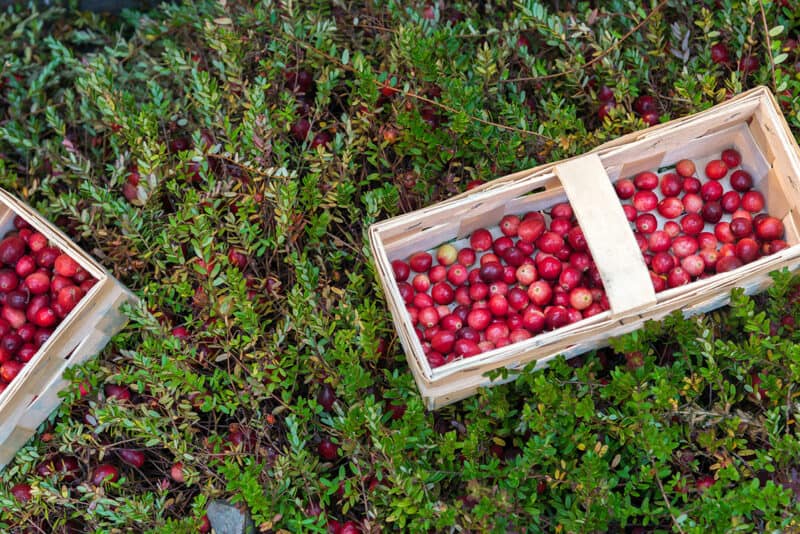
Cranberries are usually harvested in September and early October. They also produce in clusters which makes picking them much easier than other berry types.
On average, you can expect to get a pound of cranberries per plant. As the plant matures, you can expect to get upwards of three pounds per plant.
However, mature plants that produce that much may only produce every other year.
After you’ve plucked the cranberries from the plants, you’ll need to store them.
Cranberries can be stored in an airtight container for approximately one to two months. You can also freeze or dehydrate cranberries for longer-term storage.
However, be sure you wash and remove the stems of the cranberries before dehydrating or freezing them.

